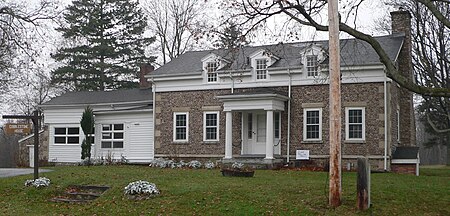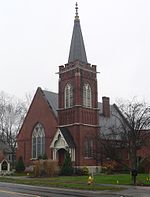Stewart Cobblestone Farmhouse
Cobblestone architectureGreek Revival houses in New York (state)Houses completed in 1835Houses in Monroe County, New YorkHouses on the National Register of Historic Places in New York (state) ... and 2 more
Monroe County, New York Registered Historic Place stubsNational Register of Historic Places in Monroe County, New York

Stewart Cobblestone Farmhouse is a historic home located at Mendon in Monroe County, New York. It is a vernacular Greek Revival style cobblestone farmhouse built about 1835. It is constructed of medium-sized field cobbles and is one of only 10 surviving cobblestone buildings in Mendon. The house features a Colonial Revival style portico added in the 20th century.It was listed on the National Register of Historic Places in 1997.
Excerpt from the Wikipedia article Stewart Cobblestone Farmhouse (License: CC BY-SA 3.0, Authors, Images).Stewart Cobblestone Farmhouse
Douglas Road,
Geographical coordinates (GPS) Address Nearby Places Show on map
Geographical coordinates (GPS)
| Latitude | Longitude |
|---|---|
| N 43.0325 ° | E -77.556388888889 ° |
Address
Douglas Road
New York, United States
Open on Google Maps








